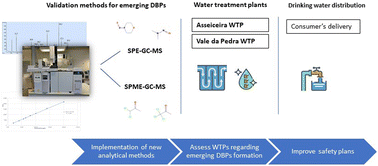Development of multi-residue gas chromatography coupled with mass spectrometry methodologies for the measurement of 15 chemically different disinfection by-products (DBPs) of emerging concern in drinking water from two different Portuguese water treatment plants†
Abstract
In water treatment plants (WTPs), chemical agents, such as chlorine and ozone, might react with organic matter and anthropogenic contaminants, forming a high diversity of disinfection by-products (DBPs). Due to the potential toxicological effects, the identification of unregulated DBPs (UR-DBPs) is critical to help water managers in the selection of effective water treatment processes, contributing to improving water safety plans. Given the limited validated analytical methods to detect UR-DBPs, here we developed new multi-residue gas chromatography coupled with mass spectrometry methodologies for the detection and quantification of 15 UR-DBPs, including aldehydes, haloketones (HKs), nitrosamines and alcohols, in drinking water matrices. Solid-phase extraction (SPE), for the nitrosamine group, and solid-phase micro extraction (SPME), for the remaining DBPs, were used as sample preparation methods. The developed methodologies allowed the quantification of target UR-DBPs at trace concentration levels (ng L−1), with method quantification limits (MQLs) ranging from 14.4 ng L−1 to 26.0 ng L−1 (SPE-GC-MS) and 2.3 ng L−1 and 1596 ng L−1 (SPME-GC-MS). The methods were applied to different drinking water matrices, considering distinct delivery points of EPAL – Empresa Portuguesa das Águas Livres WTPs. Overall, the aldehyde group, represented by decanal, nonanal and 2-ethylheaxanal, showed the highest occurrence, followed by HKs and nitrosamines. The results of this study suggested that the formation of these UR-DBPs should be further monitored in WTPs.



 Please wait while we load your content...
Please wait while we load your content...